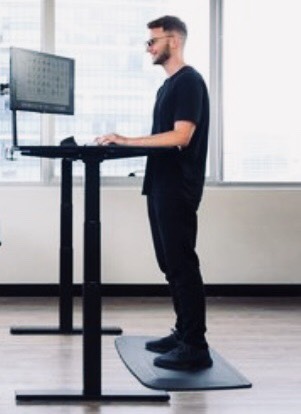If you’re new to the work-from-home game, or even if you’ve been doing it for a while, you need to protect know this: your vein health is at risk. Unlike office settings, when we're home, most of us aren’t set up to work in positions that protect our veins from the challenges of poor posture and all-day sitting.
In little bursts, that’s not a big deal. But as the weeks stretch out, and we spend more time working at home, these little problems can become major ones. In fact, slumping and sitting all day can cause blood to pool in your legs. This stretches out your vessels, impacts circulation and leads to varicose veins and other symptoms of vein disease. Those additional risks include DVT (deep vein thrombosis, a blood clot in the deep veins of your legs), plus other, also risky clots.
Want to avoid these complications? We can help! Just follow our top tips for safely working at home.

When working properly, your blood clots to protect you from excessive bleeding after a cut or injury. But, sometimes, your blood clots when it's not supposed to, and that can pose a serious threat to your health. As we mentioned, sitting or even standing for too long can make your blood pool. And that can raise your risk for clotting.
Now, when they form on your surface veins, blood clots aren't typically dangerous. Actually, when you have varicose veins, you probably already have blood clots. But you'll also have a higher risk of developing clots in your deep veins, buried well below the surface of your legs.
These clots can cause pain and swelling, and may even break off and travel to your lungs, creating a pulmonary embolism. (A life threatening condition.) Also, blood clots may form in your brain, and that can be immediately life threating. So, if you weakness in your limbs, drooping facial features, or slurring words, seek immediate medical attention.
Of course, it's crucial to stay aware of the warning signs of blood clots. But it's also critical to prevent problems. So follow our important tips for protecting your veins while working from home.

These tips will help prevent aches, pains and additional tolls on your vein health:
1. Optimize your computer screen height
Now that you’re working at home, it’s tempting to work in bed, or on your couch. But that can lead to poor posture and pressure on your veins! To protect yourself, set up your screen so that you can view it straight on, without having to look down, or twist your head left or right. Put your screen in front of you at a comfortable viewing height. Even if you’ve got to get a phone book to raise the height, it’s worth it. Why? Viewing your screen straight on will protect your posture and help you avoid back and neck pain.
2. Touch your chair backing
Your chair’s got a backing for a reason—to give you support. When you sit up too straight, or hunch forward over your desk, you’re putting pressure on your spine, either forcing it to work too hard or causing it to curve in unnatural shapes.
When you rest against your chair back, however, you support your spine’s natural curve. Plus, this position allows your chair to take on some of your body weight, which means there’s less pressure on your feet. And, with less pressure on your feet, your blood flows freely and you experience fewer vein health complications!
Finding it tough to sit back that far with comfort? No sweat! Simply extend the back of your chair by adding a cushion or towel to the chair. This will feel good on your back while ensuring you receive the benefits of proper seated posture.
3. Support your feet
When you’re sitting in that chair, your feet should be flat on the floor. And if they don’t reach? Well, you’ve got to help make sure they do, by placing books, blocks or even cushions beneath your feet.
Why is this step so crucial? Leaving your feet dangling is a major roadblock for your circulation. It puts excessive pressure on your thighs, interferes with your lower body blood flow, and raises your risk for blood clots—especially a potentially life-threatening DVT.
4. Minimize standing
Maybe you switched to a standing desk at your office. (If you did, check out our standing desk warnings here.) And maybe you want to try to do the same at home. But here’s the deal: while sitting all day is terrible for your health, standing all day isn’t much better.
Staying on your feet for hours at a time puts tons of pressure on your feet, raising your risk for varicose veins. It puts tons of pressure on your circulatory system, which could even impact the health of your arteries and heart.
So, while we applaud the desire to avoid all-day sitting and work more movement into your day, standing up isn’t the answer. Instead, follow our previous safe-sitting suggestions. And look to our final tip for ways to prevent all-day sitting disease.
5. Take Moving Breaks
Sitting or standing all day is a bad idea. When you’re at the office, it’s easy to move by building bathroom breaks and water cooler trips into your day. You can also opt to take the stairs instead of the elevator, or even walk over to a colleague’s desk instead of sending an email.
But at home? It’s a lot tougher to keep moving. So, to avoid the pitfalls of sedentary living, you’ll have to work a little bit harder. Set reminders for yourself to get up and walk around every 30 minutes. Circle your living room, climb the stairs…it doesn’t really matter, as long as you take some steps and get your blood pumping out of those legs and back to the heart. This should help protect your vein health during these safe-at-home moments.
If, however, you’re already noticing signs of a brewing vein problem, like dark or bulging veins, leg cramps, or changes in skin color? Don’t wait to seek treatment! Our vein specialists can help you right now, so make an immediate appointment with our officemake an immediate appointment with our officemake an immediate appointment with our office. Because, here’s the deal: vein problems are progressive. Delay treatment today, and you’ll face a bigger problem next month, next week or even tomorrow!
Sources: Canadian Center for Occupational Health and Safety, AARP

Scheduling
Please contact our dedicated specialists to schedule a consultation today.
2024 Texas Endovascular. All rights reserved. Website Design by Healthcare Success